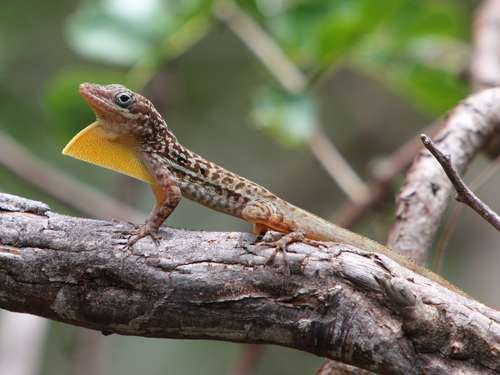
Description:
Scientific name: Anolis oculatus
Life span: Unknown
The Dominican anole is a medium-sized anole. Females are smaller in all populations. Mature males have an extended, conspicuous throat fan that is frequently brilliant yellow or orange, as well as a tail crest. In females, the throat fan is only little and less vividly colored. Blue eyes may be present in some. Dominican anoles can occasionally change their color, although not as frequently as some other anoles.
Its base hues range from light tan or ash gray to dark brown or green. Moreover, markings differ greatly. In all populations, adult males exhibit some mix of light-colored or white spotting dispersed throughout the majority of their bodies.
Native Region/Habitat
Only the island of Dominica, one of the few in the Lesser Antilles to have maintained its native reptile and amphibian fauna throughout the past 200 years, is home to the Dominican anole. It and the Dominican ground lizard are the only two lizard species that are native to Dominica. In Dominica, it is the sole type of native anole. It is widespread throughout the island’s habitats and regions up to a height of around 900 meters, though an invasive anole species is driving it out of the southwest coastal region.

Behavior:
Territoriality is a trait shared by both sexes. Males will often mate with females whose territories overlap their own because male territories are roughly twice as large as those of females. In locations with high population densities, female territories may overlap. According to research, male migration is what drives gene flow within the species, indicating that females do not have strong mate preferences. Male and female adults spend the majority of their time immobile; therefore, migration likely occurs during the juvenile stage.
Dominican anoles often perch on a tree or other vertical object while active in order to look downward for food or other lizards, however this position leaves them open to attack by raptors. Males will extend and retract their vividly colored neck fans from this vantage point in an effort to both entice females and fend off rivals. Moreover, men will bobble their heads or do what appears to be “push-ups” with their front legs. In the event of a fight, an invading adult may circle closely while expanding their body and gaping their mouths to appear more intimidating. When there is physical contact during these encounters, it rarely results in bodily injury and is usually brief. Even if the intruder is larger than the protecting male, it will normally flee after these encounters.
Although there are differences in activity patterns amongst populations, the species as a whole is often most active during the colder parts of the day. In Dominica’s west coast, it is active all day with peaks at dawn and dusk, however in communities of rain forest, it normally remains at high perches and is dormant during the middle of the day. The Dominican anole rests by hanging to leaves at the tips of branches at night, away from more powerful nocturnal predators.
Care As a pet/In captivity:
Anolis cristatellus, a newly arrived rival, established itself in Dominica between 1997 and 2002 and, as of 2007, had started to displace the Dominican anole in the southwest coastal region near Roseau. The Dominican anole has almost completely disappeared from this region. In order to maintain this color form, some writers suggested a captive breeding effort because that is practically the entire range of the southern ecotype. There isn’t much research on captive animals because of this.
Table





